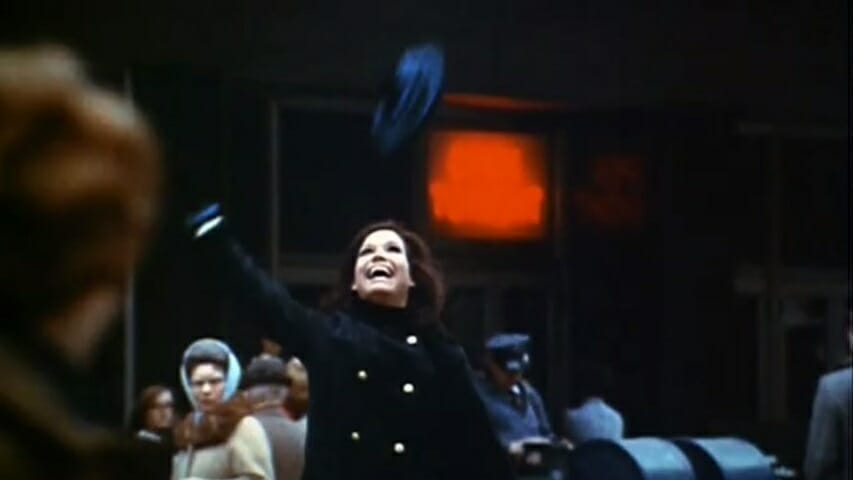The Mary Tyler Moore Show at 50: Yep, Still Good

50 years ago this week, on September 19, 1970, the face of television changed forever with the premiere of The Mary Tyler Moore Show. America grew to embrace Twin Cities news producer Mary Richards and her close circle of friends and co-workers over seven seasons, as the show came to define the workplace sitcom. Its legacy is both ubiquitous through its successors and obfuscated by its imitators, but on its own merits, Mary Tyler Moore holds up as both an evolutionary step between the 1960s and the 1970s, and a hilarious sitcom with an all-star cast and crew.
The Mary Tyler Moore is remembered today for being one of the first “grownup” sitcoms, featuring characters who acted and spoke to each other like actual adults. It was also a groundbreaking show in how it focused on a woman who chose her career over marriage. Its greatest strength, though, and the reason it remains one of the best sitcoms ever produced 50 years later, was always its cast.
The cast was simply stacked, from top to bottom. Cloris Leachman would win a Best Supporting Actress Oscar while still giving her all on the small screen as feminist landlady Phyllis Lindstrom, while Valerie Harper became an icon as Mary’s best friend, Rhoda Morgenstern. Ted Knight found his signature role in newscaster Ted Baxter, the quintessential himbo of his era, and Gavin MacLeod portrayed the most catty heterosexual male of all-time as writer Murray Slaughter. Ed Asner was gruff but loveable, an accidental icon of the bear community, while John Amos was the best part of the handful of episodes he was in as Gordy the Weatherman.
While most people know Betty White today as the naive Rose Nylund on The Golden Girls, her choice to play Rose was a direct response to how viewers saw her as sex-positive homemaker Sue Ann Nivens on Mary Tyler Moore, which in turn played on White’s original typecasting as a saccharine TV personality. And a lot of Moore’s own spectacular performance as an icy mother in 1980’s Ordinary People played on the audience’s perception of her from MTM and The Dick Van Dyke Show.
Some things certainly have changed (and become dated) since The Mary Tyler Moore Show first aired, from references to inflation, to celebrity crushes on Paul Newman, Robert Redford, and Warren Beatty (all of whom are mentioned at least twice). The way MTM handles the social issues of its day are of its time: Murray’s wife Marie doesn’t want another child, not so much because of any pro-choice sentiment as out of concern for the “population boom,” and so they immediately adopt a Vietnamese refugee. Gay people are treated relatively okay but still as stereotypes, and you can count the number of Black actors featured throughout its run on one hand.
Sexual politics are handled with a laugh, even when the sportscaster is exchanging favors with women for Twins tickets, or several men don’t know the meaning of the word “no” when it comes to a relationship. MTM’s treatment of weight issues are also glaring, as Rhoda is constantly treated as “the fat one” while not being overweight at all. In spite of this, The Mary Tyler Moore Show ages especially well in terms of handling new stages of life, and in the struggles to establish and maintain boundaries between family, friends, and co-workers.
“Chuckles Bites The Dust”, the seventh episode of the sixth season, was proclaimed the greatest episode in television history by TV Guide in 1999, and many others agree. While it’s a bit of a reach to call it the greatest episode of all time (or even this series), it resonates because of how people hilariously react to a colleague’s death, and how Mary reacts to the reaction before giving in to the absurdity of it all at Chuckles The Clown’s funeral. And unlike most long running sitcoms, which too often drag on past their peak, MTM was still at the top of its game at the end, with the iconic finale deftly combining wistfulness with humor.
The Mary Tyler Moore Show is more than just about a woman who could turn the world on with her smile, or the Peignot font of the title sequence, or even Mary Richards tossing her hat. It is a realistic story of a woman moving on with her life after a failed engagement, peppered with absurdist humor and biting wisecracks, as well as the story of one person building a chosen family while realizing she doesn’t need a spouse to make her life complete. This message had to be fought for by Mary Tyler Moore and her then-husband Grant Tinker, as well as the show’s creators, James L. Brooks and Allan Burns, and in doing so, allowed similar stories to be told in the future, even if they took place in the past. Mary Tyler Moore is the evolutionary link between I Love Lucy and The Marvelous Mrs. Maisel, and a crucial show in the history of TV—one that you shouldn’t miss.
The Mary Tyler Moore Show is streaming on Hulu.
Tom Keiser is a freelance writer for hire. He’s on Twitter @thomasdkeiser.



































